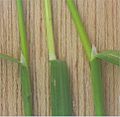Annual meadow grass facts for kids
Quick facts for kids Annual meadow grass |
|
|---|---|
 |
|
| Scientific classification | |
| Genus: |
Poa
|
| Species: |
annua
|
Poa annua, also called annual meadow grass or annual bluegrass, is a common type of grass. You can find it growing in many places around the world, especially in areas with mild weather. Even though its name suggests it lives for only one year (annual), some types of Poa annua can live for many years. Scientists think this grass might be a mix of two other types of grass: Poa supina and Poa infirma.
Contents
What Poa Annua Looks Like
This grass has roots that spread out a little. Its stem grows about 15 to 25 centimeters (6 to 10 inches) tall. The stem is a bit flat, like it has been folded.
Leaves and Flowers
The leaves are bright green and short. Their tips are blunt, shaped a bit like the front of a small boat. They feel soft and hang down. Long parts of the leaf wrap around the stem. The leaves are smooth on both sides and have tiny saw-like edges. Sometimes, these edges are across the leaf.
The flowers grow in a loose, triangle-shaped cluster called a panicle. This cluster is usually 5 to 7.5 centimeters (2 to 3 inches) long. The small flower parts, called spikelets, grow on tiny stalks. They do not have a bristle-like part called an awn. Each spikelet is about 1 to 2 centimeters (3/8 to 3/4 inches) long when the plant flowers. They are spread out on thin branches and can sometimes look purple.
Ligule (Leaf Feature)
A special part of the leaf, called the ligule, is pointed and looks silvery. This is a good way to tell Poa annua apart from other similar grasses. For example, Poa pratensis has a square-shaped ligule. Poa trivialis has a pointed ligule, but it is not as silvery.
Growing Season
Poa annua can flower almost all year, except during very cold winters. Its seeds ripen and fall off for about eight months of the year. This grass grows very quickly from a seed. It can flower within six weeks, make new seeds, and then die.
Where the Name Comes From
The name Poa comes from an old Greek word. It was used for a type of grass fed to animals. The word Annua comes from Latin, meaning 'annual' or 'lasting a year'.
Where Poa Annua Grows
Poa annua is a very common plant. Many people see it as a weed in gardens and on farms. It often grows in lawns, where it is also seen as a weed. You can also find it in empty or unused areas.
In Golf Courses
Many golf putting greens, like the famous ones at Oakmont Country Club, are made of Poa annua. However, some golf courses have changed to using a different type of grass called creeping bentgrass (Agrostis stolonifera).
In Cold Climates
This grass has also spread to very cold places. It has been found on King George Island in the Antarctic. It is considered an invasive species there. It also grows on Australia's subantarctic Heard and Macquarie Islands.
See also
 In Spanish: Poa anual para niños
In Spanish: Poa anual para niños
Images for kids






